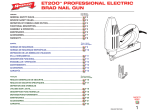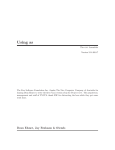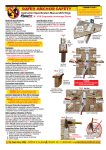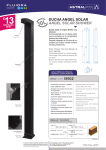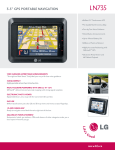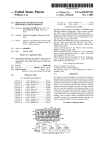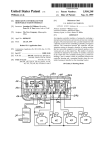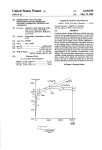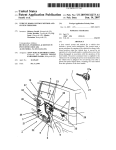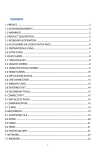Download Computer finger mouse
Transcript
US 20060007152A1 (19) United States (12) Patent Application Publication (10) Pub. N0.: US 2006/0007152 A1 Wang (43) Pub. Date: Jan. 12, 2006 (54) COMPUTER FINGER MOUSE Publication Classi?cation (76) Inventor: Yuguang Wang, Mesa, AZ (US) Correspondence Address: (51) Int. Cl. G096 5/08 (52) (2006.01) Us. 01. ............................................................ ..345/163 Yuguang Wang 2606 S. Saratoga Ave. Mesa, AZ 85202 (US) (21) Appl. No.: 11/172,761 (22) Filed: Jul. 2, 2005 (57) A computer ?nger mouse includes a concave structure for embrace the ?ngertips of a hand in a relaxed positions. The concave structure alloWs the mouse be held and manipulated by the ?ngertips of a hand only. A hand holding and manipulating the computer ?nger mouse is in a naturally relaxed and curled position, Without requiring static tWisting of the hand, Wrist, or forearm. As a result, fatigue, discom Related US. Application Data (60) Provisional application No. 60/586,044, ?led on Jul. 7, 2004. . I ABSTRACT 36 1? fort, and pain are minimized or eliminated even after a long period of continuous use. 16 32 23 12 31 Patent Application Publication Jan. 12, 2006 Sheet 1 0f 8 US 2006/0007152 A1 12 1O 31 Patent Application Publication Jan. 12, 2006 Sheet 2 0f 8 US 2006/0007152 A1 32 26 i: | 2 Patent Application Publication Jan. 12, 2006 Sheet 3 0f 8 36 US 2006/0007152 A1 Patent Application Publication Jan. 12, 2006 Sheet 4 0f 8 21 US 2006/0007152 A1 12 . l3 _' 33 i FIG. 4 w Patent Application Publication Jan. 12, 2006 Sheet 5 0f 8 12 17 36 16 US 2006/0007152 A1 22 32 10 Patent Application Publication Jan. 12, 2006 Sheet 6 0f 8 US 2006/0007152 A1 Patent Application Publication Jan. 12, 2006 Sheet 7 0f 8 ' 121 123 ,125 US 2006/0007152 A1 127 135 133 me. 11' 135 FIG. 12 Patent Application Publication Jan. 12, 2006 Sheet 8 0f 8 US 2006/0007152 A1 00 BIG‘. 13 200 Fl6.14 Jan. 12, 2006 US 2006/0007152 A1 COMPUTER FINGER MOUSE and their joints. It also shortens the distance betWeen the BACKGROUND OF THE INVENTION-PRIOR ART mouse and the Wrist. The Wrist and the forearm have to sWing to left or right, move forWard or backWard harder to produce needed mouse movement. [0001] Many software programs use movable cursors for selecting data and objects or drawing on a display monitor. The cursors are generally controlled by a manually manipu lated pointing device connected to a computer. Common [0005] Accordingly the primary object of the present pointing devices include the mouse, trackball, touch pad, and digitiZing tablet. invention is to provide an ergonomic computer mouse Which is shaped to alloW a hand holding and manipulating it to [0002] remain in a natural, untWisted, and relaxed position. Another object of the invention is to provide an ergonomic computer The mouse is the most popular pointing device. It includes a housing that is slidably moved about on a ?at, stationary surface. The housing contains a motion sensor on its bottom side for tracking its movement, one to three buttons on its front edge, and electronic circuitry for com municating With an attached computer. When the mouse is moved about, the cursor moves in corresponding directions; and When the buttons are pressed, certain actions can be performed, depending on the softWare application using the mouse. The internal parts, and electrical and softWare opera tions of computer mice are Well knoWn in the art. [0003] Most mice, such as the one shoWn in US. Pat. No. D302,426 to Bradley et al., are substantially Wider than they are tall, and have generally symmetrical sides so that they can be used by either the right or the left hand. Some mice are specially shaped for providing an optimal ?t for a user’s right hand. The mouse shoWn in US. Pat. No. D328,597 to BACKGROUND OF THE INVENTION-OBJECT AND SUMMARY ?nger mouse Which minimiZes or eliminates fatigue, dis comfort, and pain even after prolonged and continuous use. Further objects and advantages of the invention Will become apparent from a consideration of the draWings and ensuing description. These and other objects are achieved With an unique computer ?nger mouse having a concave ?nger supporting structure for holding the mouse on a ?at surface by using the ?ngertips of a hand only Without needing help from the thumb. [0006] This method of holding and manipulating a com puter mouse fully takes advantage of the ?exibility and mobility of human ?ngers. A computer mouse is moved forWard or backWard by stretching out or curling the ?ngers, respectively. This makes handling computer mouse a relax ation than a stress. Clouss, and sold under the trademark “MouseMan” by Logitech Inc. in Fremont, Calif., has a slightly angled but generally horiZontal top surface for supporting the ?ngers and palm of a right hand. The Microsoft Mouse, Version 2, sold by Microsoft Corporation in Redmond, Wash., includes mouse in accordance With the ?rst embodiment of the invention. a concave left side for closely engaging the base of the thumb and palm of a right hand. The mouse shoWn in US. Pat. No. 4,862,165 to Gart includes a surface for supporting mouse of FIG. 1, and some ?ngers in substantially curled positions. Some ergo nomic mice, including the Logitech MouseManTM, are also BRIEF DESCRIPTION OF THE DRAWINGS [0007] [0008] [0009] FIG. 1 is a perspective vieW of the computer ?nger FIG. 2 is a top plane vieW of the computer ?nger FIG. 3 is a top plane vieW of a user’s hand engaging With the computer ?nger mouse of FIG. 1, and made in left-handed versions. [0004] All prior art mice have a generally horiZontal, primary supporting surface for supporting a hand in a horiZontal position, as exempli?ed by the draWing ?gures of US. Pat. No. 5,157,381 to Cheng, and the draWings in the user’s manual of the Microsoft Mouse. The mice in the prior art require using both thumb and the ?ngers of a hand to hold the edges of left and right side of the mouse. Because the prior art mice require be hold on the both edges of left and right sides, therefore prior art mice force the hand, Wrist, and [0010] FIG. 4 is a left side elevational vieW of the computer ?nger mouse of FIG. 1, and [0011] FIG. 5 is a left side elevational vieW of the com puter ?nger mouse of FIG. 1 With an alternative extra button added, and [0012] FIG. 6 is a front side elevational vieW of the computer ?nger mouse taken from line 6 of FIG. 2, and [0013] FIG. 7 is a rear side elevational vieW of the forearm to be tWisted out of their natural and relaxed computer ?nger mouse taken from line 7 of FIG. 2, and positions, and require constant muscular force to be applied to the hand, Wrist, and forearm to maintain their positions. For a three-button mouse, the fore, middle, and ring ?ngers [0014] FIG. 8 is a vertical sectional vieW of the computer ?nger mouse taken along the line 8-8 of FIG. 2, and must be kept in constant tension to prevent them from resting too heavily on the buttons and depressing them [0015] FIG. 9 is a vertical sectional vieW of the computer ?nger mouse taken along the line 9-9 of FIG. 2, and inadvertently. To avoid tWisting the Wrist When holding a computer mouse, an ergonomic computer mouse shoWn in US. Pat. No. 5,576,733 to L0 has chosen a bell-like shape. The hand holds the mouse Within a loose ?st and is in an upright position: the little ?nger side of the hand rests on the desk, and the ?ngers and palm generally de?ne a vertical plane. This position eliminates the deviation of a Wrist When [0016] FIG. 10 is a vertical sectional vieW of the computer ?nger mouse taken along the line 10-10 of FIG. 2. [0017] FIG. 11 is a perspective vieW of the computer ?nger mouse in accordance With the second embodiment of the invention. the hand holds the mouse in a static state. But this position [0018] can not take advantage the ?exibility and mobility of ?ngers mouse of FIG. 11, and FIG. 12 is a top plane vieW of the computer ?nger Jan. 12, 2006 US 2006/0007152 A1 [0019] FIG. 13 is a top plane vieW of the computer ?nger mouse in accordance With the third embodiment of the invention. [0020] FIG. 14 is a left side elevational vieW of the computer ?nger mouse of FIG. 13. are hold betWeen thumb and ?ngers or hold in the palm. Less movement for the Wrist and the forearm means less stress, less fatigue and less damage. When it is necessary, the thumb can move inWard to press the button(s) disposed at the edge of the rear upper body. Because of the symmetrical structure and shape of mouse 10 along the line 8-8 of FIG. 2, the left-handed users can use the mouse the same Way as DESCRIPTION OF THE INVENTION the right-handed users. Although the above mode of using [0021] Turning noW to the drawings, in Which like refer ence characters indicate corresponding elements throughout the several vieWs, attention is ?rst directed to FIG. 1 in the mouse is preferred, user can choose holding the mouse betWeen the thumb and ?ngers and manipulating it the same Way as using the conventional prior art mice. Which is seen a computer ?nger mouse 10 having a upper [0024] body With generally oval shaped contour, a concave struc ture across middle portion of the upper body laterally, several buttons, a scroll Wheel, and a horiZontal ?at bottom surface. 21 With part of surface 22 can be seen. Finger space 23 is hiding behind member 40. The button 31 is extended at the [0022] mice. Button 33 is located at the left edge of rear body and can be easily reached by moving the thumb inWard. And this movement of thumb is natural and With little stress. The As further seen in FIG. 2 in Which is seen the computer ?nger mouse 10 including a front upper body 16 having surface 17, a rear upper body 12 having surface 13. A concave structure includes three ?nger spaces, ?nger In the left elevational vieW of FIG. 4 ?nger space edge of ?nger space 21 and can be easily reached by stretching out the indeX ?nger just like using the prior art scroll Wheel 36 can be seen at middle of front body 16. space 21, ?nger space 23 and ?nger space 25. Finger space 21 having surface 22, ?nger space 23 having surface 24, and [0025] FIG. 5 is the left elevational vieW of an alternative embodiment of the invention. An eXtra button 37 is added ?nger space 25 having surface 26 are disposed across the middle of the upper body laterally, betWeen the front upper body 16 and rear upper body 12. Finger space 22 and ?nger space 23 is separated by member 40. Finger space 23 and ?nger space 25 is separated by member 41. Scroll Wheel 36 is located at the middle of front upper body 16. Buttons 31 neXt to button 33 as shoWn. If button 33 serves as the left-click button of a conventional computer mouse, button 37 can serve as the right-click button, and vise versa Similarly, an eXtra button 38 can be added neXt to the button 34, opposite to button 37. is located on left side of front upper body 16 eXtended [0026] FIG. 6 and FIG. 7 depict the symmetrical shape betWeen the upper-left edge of 16 and the edge of ?nger and structure of ?nger mouse 10 from both front and rear side elevational vieWs. space 21. Buttons 32 is located on right side of front upper body 16 eXtended betWeen the upper-right edge of 16 and the edge of ?nger space 25. Button 33 is located on the left edge of rear upper body 12. Button 34 is located on the right edge of rear upper body 12. The upper body, the buttons, and the scroll Wheel and the mouse bottom surface can be manufactured using the same materials and processes as those of the conventional prior art computer mice. [0023] FIG. 3 demonstrates the preferred mode of using the computer ?nger mouse 10. The right-handed user(s) insert the indeX ?ngers 51 into ?nger space 21, the middle ?nger 53 into ?nger space 23, and the ring ?nger 55 into ?nger space 25, respectively. The small ?nger can rests Wherever users like. All the ?ngers are curled naturally With the ?ngertips nearly perpendicular to the surface on Which the ?nger mouse is rested. The thumb is bent naturally and rested on the same surface on Which the ?nger mouse is rested. In this position, the ?ngers, the hand, and the forearm are aligned. All the joints of ?ngers, thumb and Wrist are in the comfortable neutral states Without any biased tWist applied. To manipulate the ?nger mouse, With slight doWn [0027] As further seen in FIG. 8, the ?nger space 23 has a nearly V shaped vertical sectional vieW. Small circum stance at the bottom of ?nger spaces is for embracing the ?ngertips and big circumstance at top is to make the ?n gertips comfortable When the ?ngers are stretched out or curled. The surface of ?nger space 22 can be covered With tiny goose bump or Wove paper like structures to make it coarse. And those structures can be made of same material as the ?nger mouse body or soft rubber, plastics or ?bers. The vertical sectional vieWs of ?nger space 21 and ?nger space 25 have the same shapes as that of ?nger space 23. The surfaces of ?nger space 21 and 25 also have same shapes and features as those of ?nger space 23. A scroll Wheel 36 is located at middle of front body surface 17. [0028] FIG. 9 and FIG. 10 further depict the shapes and positions of ?nger space 21, 23, and 25. Round shapes at bottoms of ?nger space 21, 23, and 25 accommodate the shape of users ?ngertips. Elevated member 40 and 41 Will make holding and manipulating the mouse more secure. Ward pressure from the ?ngertips, the mouse 10 can be [0029] moved forWard by stretching out the ?ngers and moved backWard by curling the ?ngers further Without moving any other body part. The above stretching and curling the ?ngers ?nger mouse 100 in accordance With the second embodi ment of the invention. The computer ?nger mouse 100 including a front upper body 116, a rear upper body 112. A concave structure includes four ?nger spaces, ?nger space are the most easy and natural movements of human body. It is more like a relaxation than a stress. The lateral movement of ?nger mouse 10 can be realiZed by sWing the hand and the forearm to the left or to the right, respectively. The distance from the Wrist to the ?ngertips is longer than the distances from the Wrist to the thumb tip or center of palm. To sWing a ?nger mouse hold by the ?ngertips Will require less movement of Wrist and forearm than the prior art mice Which FIG. 11 is a perspective vieW of the computer 121, ?nger space 123, ?nger space 125 and ?nger space 127. Finger space 121, ?nger space 123, ?nger space 125 and ?nger space 127 are disposed across the middle of the upper mouse body laterally, betWeen the front upper body 116 and rear upper body 112. Button 133 is located on the left edge of rear upper body 112. Button 134 is located on the right edge of rear upper body 112. Button 135 is located on the Jan. 12, 2006 US 2006/0007152 A1 computer ?nger mouse 10 in FIG. 1. digitiZing tablet by providing it With a cross-hair and suit able electronics Well knoWn in the art. The separations betWeen the ?nger spaces can be shaped to alloW the ?nger mouse to be picked up Without slipping by closing the ?ngertips. The rear body can also be shaped to alloW the ?nger mouse be picked up by moving the thumb toWard the [0030] FIG. 12 is the top plane vieW of computer ?nger changed for accommodating different hand siZe and shapes. lower middle edge of rear upper body 112. Scroll Wheel 137 is located at the middle of rear upper body 112. The mouse body, the concave structure, the buttons, and the scroll Wheel can be manufactured using the same materials and processes as those of the conventional prior art computer mice and mouse of FIG. 11. The four ?nger spaces have the similar shapes and features of ?nger spaces on ?nger mouse 10 in FIG. 1. They can be made of same material as that of upper body or can be made of soft, ?exible material for better ?ngertips embracing. The four ?nger spaces can be arranged and shaped for right-handed users or left-handed users only. They also can be made symmetrical for both right-handed and left-handed users. The Way to hold and manipulate ?nger mouse 100 is similar to that of ?nger mouse 10. For right-handed users, if button 133 is treated as left button, then button 135 Will be treated as right button and vase versa. For left-handed users, button 134 and button 135 Will be used as right and left button combination. All the buttons on ?nger mouse 100 are designed for the thumbs only. So is the scroll Wheel 17. [0031] FIG. 13 and FIG. 14 give the top plane vieW and left elevational vieW of the computer ?nger mouse 200 in accordance With the third embodiment of the invention. Finger mouse 200 is almost identical to ?nger mouse 10 except the shape of ?nger spaces. Instead of having sepa ?ngertips. The overall dimensions of the mouse can be Therefore, the scope of the invention should not be deter mined by the examples given, but only by the appended claims and their legal equivalents. 1. A computer ?nger mouse for translation over a hori Zontal stationary surface, comprising: a generally horiZontal bottom surface for stably and translatably positioning said ?nger mouse over said stationary surface; an upper body attached on top of said bottom surface for housing needed functional parts, said upper body hav ing a front upper body and a rear upper body; and a concave structure including a plurality of ?nger spaces is disposed across the middle of said upper body laterally, said ?nger spaces are siZed and shaped for embrace ?ngertips of a hand securely and comfortably, so that said ?nger mouse Will folloW the movement of said ?ngertips over said horiZontal stationary surface Without needing help from the thumb of said hand. rated ?nger spaces, ?nger mouse 200 has a concave structure containing a narroW and continuous ?nger space for all ?ngers. The concave structure is made of soft and ?exible 2. The computer ?nger mouse of claim 1 Wherein said front upper body has tWo buttons disposed on left side and material for better embracing the ?ngertips. The concave of ?nger of said hand; if one said button is used to generate left-click signals, then the other said button Will be used to structure of ?nger mouse 200 can be made symmetrical for both right-handed and left-handed users. It also can be made for right-handed or left-handed users only. Finger mouse 200 is handled the same Way as that of ?nger mouse 10. right side, respectively; said buttons can be pressed by one generate right-click said signals. 3. The computer mouse of claim 1, further including a scroll Wheel disposed at middle of said front upper body for generating scrolling signals When rotated by a said ?nger of Conclusion, Rami?cations, and Scope [0032] Accordingly the concave structure of the computer ?nger mouse, in all embodiments, alloWs the ?nger mouse to be held and manipulated mainly by the ?ngertips of a hand only. The hand remains in a relaxed and naturally curled position. It eliminates the substantial tWisting of the hand, Wrist, and forearm that are common to users of prior art mice. The naturally curled position hand distributes its Weight betWeen its ?ngertips and loWer palm (FIG. 3), Which eliminates the pressure sores on the Wrist that prior art mice can cause. As a result, fatigue, discomfort, and pain are minimiZed or eliminated even after a long period of con tinuous use. [0033] The present invention only relates to the ergonomic aspects of a computer mouse. It can employ any electronic communication and motion sensing technologies Well knoWn in the art, or any that may arise in the future. said hand. 4. The computer mouse of claim 1, further including a plurality of buttons disposed aground the edge of said rear upper body for generating said left-click or said right-click signals When pressed by said thumb of said hand. 5. A computer ?nger mouse for translation over a hori Zontal stationary surface, comprising: a generally horiZontal bottom surface for stably and translatably positioning said ?nger mouse over said stationary surface; an upper body attached on top of said bottom surface for housing needed functional parts, said upper body hav ing a front upper body and a rear upper body; and a concave structure including a plurality of ?nger spaces is disposed across the middle of said upper body laterally, said ?nger spaces are siZed and shaped for embrace ?ngertips of a hand securely and comfortably, [0034] Although the above descriptions are speci?c, they so that said ?nger mouse Will folloW the movement of should not be considered as limitations on the scope of the said ?ngertips over said horiZontal stationary surface Without needing help from the thumb of said hand. invention, but only as examples of the embodiments shoWn. Many other rami?cations and variations are possible Within the teachings of the invention. For example, the structure for embracing ?ngertips can have different shape, siZe and location; different number of ?nger spaces can be provided; 6. The computer mouse of claim 5, further including a scroll Wheel disposed at middle of said rear upper body for generating scrolling signals When rotated by said thumb of and the number of buttons and their positions an also be said hand. 7. The computer mouse of claim 5, further including a varied. The mouse can be easily adapted for use With a plurality of buttons disposed aground the edge of said rear Jan. 12, 2006 US 2006/0007152 A1 upper body for generating said left-click or said right-click signals When pressed by said thumb of said hand. 8. A computer ?nger mouse for translation over a hori Zontal stationary surface, comprising: a generally horiZontal bottom surface for stably and translatably positioning said ?nger mouse over said stationary surface; an upper body attached on top of said bottom surface for housing needed functional parts, said upper body hav ing a front upper body and a rear upper body; and a concave structure including a narroW and continuous 11. The computer mouse of claim 8, further including a plurality of buttons disposed aground the edge of said rear upper body for generating said left-click or said right-click signals When pressed by said thumb of said hand. 12. The method of using a computer ?nger mouse over a horiZontal stationary surface for providing mouse signals to a computer, comprising the steps of; inserting the ?ngertips of a user’s hand into the ?nger spaces With said hand in a naturally relaXed and curled hand position; said hand and the Wrist and the forearm are nearly aligned; ?nger space is disposed across the middle of said upper body laterally, said ?nger space is siZed and shaped for embrace ?ngertips of a hand securely and comfortably, stretching out the ?ngers to move said ?nger mouse forWard and curling said ?ngers further to move said so that said ?nger mouse Will folloW the movement of ?nger mouse backWard Without needing the help from the thumb; said ?ngertips over said horiZontal stationary surface Without needing help from the thumb of said hand. 9. The computer ?nger mouse of claim 8 Wherein said front upper body has tWo buttons disposed on left side and right side, respectively; said buttons can be pressed by one of ?nger of said hand; if one said button is used to generate left-click signals, then the other said button Will be used to generate right-click said signals. 10. The computer mouse of claim 8, further including a scroll Wheel disposed at middle of said front upper body for generating scrolling signals When rotated by a said ?nger of said hand. sWinging said hand and said forearm rightWard or left Ward, respectively, to move said ?nger mouse to the left or the right, correspondingly, Without needing the help from said thumb; and moving said thumb inWard to push the buttons on the edge of said ?nger mouse to perform the right-click or left-click button function.













